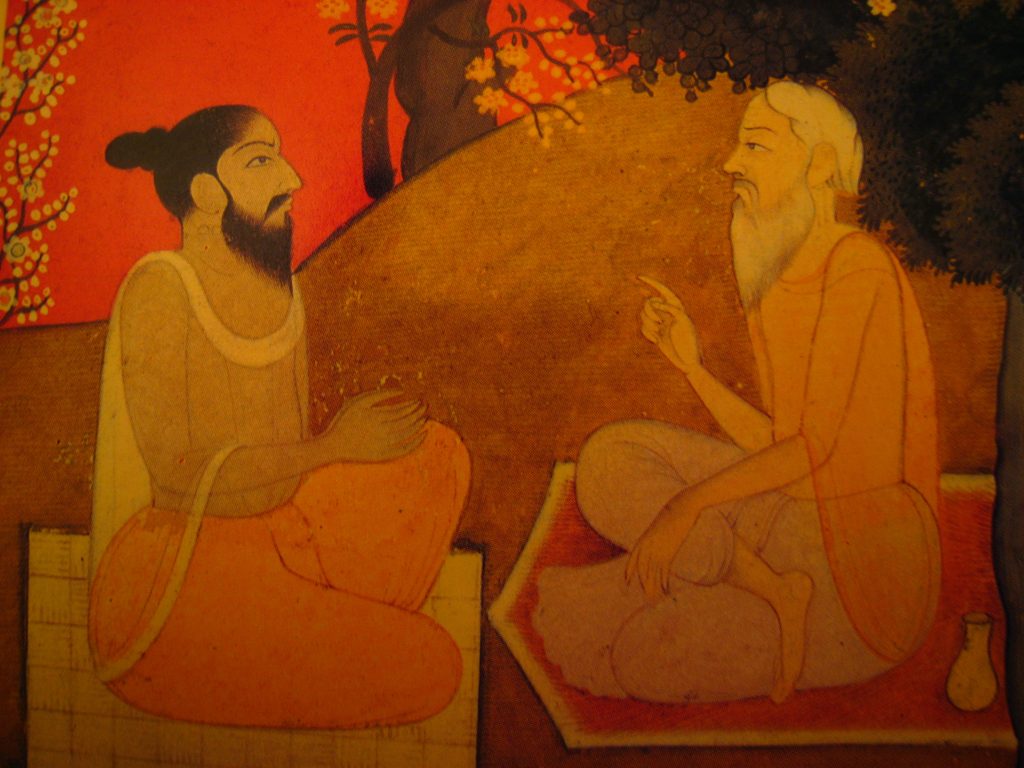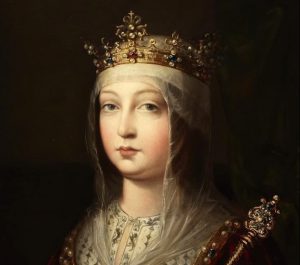The earliest form of Hindu tradition occurred during the Vedic period in Indian history.1 The Upanishads, works of philosophical thought, were a major contribution to the development of Hinduism, taking place long after the Aryan migrations to the Indus and Ganges River valleys and their subsequent interaction with the Dravidian inhabitants. Although Hinduism has no established founder, it is one of the first forms of religious practice, dating back to at least 1500 B.C.E., making it one of the world’s most important and oldest world religions.

The word Hindu is derived from shindhu, the ancient name for the Indus River, where the Aryans are supposed to have first established themselves. Therefore, the name Hinduism could have been influenced by the geographic location of the Aryans, the first to practice Hindu philosophical thought. Early Indo-European migrations, starting around 1500 B.C.E., led the Aryans to enter India and settle in the Punjab region of the Indus River Valley. There they met Dravidians, an already established people, descendants of the earlier Harappan civilization. Although the Aryans were in constant conflict with the Dravidians, and among themselves as well, the Aryans learned agricultural techniques and possibly belief systems from the Dravidians. Eventually, these two groups merged into one culture, combining ideas from the Dravidians with ritual practices from the four Vedas of the Aryans, forming the foundations of Hinduism.
During the Vedic Age, from roughly 1500 to 500 B.C.E., Aryan beliefs were contained in the four Vedas, the oldest of which was the Rig Veda, which mentions their chief deity Indra. He was a violent god, leader of battles and the god of war. Aryan beliefs included sacrifices to other gods too, such as the gods of sun, sky, moon, fire, health, and disease. The purpose of their sacrifices was to ensure victory in wars and military success. Ethics remained a minor aspect of religious practice during the Vedic Age and in the Aryan religion. The beginnings of Hinduism occurred with a popular dissatisfaction with the practice of sacrifices. Individuals sought after a more intimate and meaningful relationship with their gods.2

Along the Ganges river valley, around 800 B.C.E., many individuals began to contemplate the deeper spiritual understanding of the Vedas. Many of these thinkers attracted disciples, and while studying the practices established by the orally transmitted works and characteristics of the Vedas, the teachings of these individuals became the collected writings known as the Upanishads.
Wisdom and knowledge was achieved with the Upanishads in the years between 800-400 B.C.E. Throughout these works, the principle of Brahman, the universal and eternal soul, is explained. In an excerpt from the Katha Upanishad, Brahman is shown to be the Creator:
The all-knowing Self was never born, Nor will it die. Beyond cause and effect, This Self is eternal and immutable. When the body dies, the Self does not die.” —Katha Upanishad
Dravidians had believed in a form of reincarnation, which became one of the main concepts within Hinduism. It is the belief that souls of individuals, or one’s Atman, is actually of the same substance as the universal soul, Brahman. The idea of Atman can be see in the following excerpt from the Katha Upanishad:
There are two selves, the separate ego and the indivisible Atman. When One rises above I and me and mine, the Atman is revealed as one’s real Self. —Katha Upanishad
The Atman seeks to reunite with Brahman, but is hindered from merging with Brahman through ignorance, requiring multiple cycles of reincarnation, or samsara, in order to come to the understanding that one’s Atman is eternal with the Self or Brahman. This learning process is based on the practice of karma, which is rewarded by practices of good deeds, self-control, honesty, and charity while avoiding greed and envy. The ultimate goal was moksha, which was the final release from the cycle of samsara with the merging of one’s Atman with Brahman. The following excerpt in the Kena Upanishad shows the possible merge of the individual soul with Brahman:
Those who realize Brahman shall conquer All evil and attain the supreme state. Truly they shall attain the supreme state!” —Kena Upanishad
Moksha, the dreamless sleep that came with permanent liberation of human pain and suffering, was thought to be achieved through meditation and asceticism. This is the practice of living a simple life and denying all worldly pleasures.3
Today, Hinduism is the world’s third largest religion after Christianity and Islam.4 The Indian efforts to achieve understanding of the world through nature and philosophical thought served as a bridge to the development of Hinduism from the Vedic Age. The Upanishads, through the concepts of Brahman, Atman, samsara, karma and moksha, allowed for a new beginning in society’s understanding of the spiritual world.
- Ancient History Encyclopedia, (2009-2016), s.v. “Religion Timeline.” ↵
- Jerry H. Bentley, Herbert F. Ziegler, Traditions and Encounters: A Global Perspective on the Past Volume 1: From the Beginning to 1500 (New York, NY: McGraw-Hill, 2011), 76-78. ↵
- Jerry H. Bentley, Herbert F. Ziegler, Traditions and Encounters: A Global Perspective on the Past Volume 1: From the Beginning to 1500 (New York, NY: McGraw-Hill, 2011), 80-82. ↵
- Religious Tolerance, December 2015, s.v. “Religions of the world: Numbers of adherents of major religions, their geographical distribution, date founded, and sacred texts,” by B.A. Robinson. ↵



37 comments
Vanessa Rodriguez
Amazing article. I found it so interesting how the Aryans and Dravidians merged together despite constant fighting with one another. Once merged, Aryan adopted Dravidian beliefs and vice versa leading to the foundation of Hinduism. It is crazy to think that a religion very active now, was founded so long ago and kept advancing with the help of the Upanishads. I really enjoyed your article, great job!
Grace Ibarra
I really enjoyed how thoroughly researched this article was. I thought it was very informative and definitely allowed for a more insightful view of the Upanishads for the reader. I especially liked the key terms this author included as well as their meanings which allowed for a better understanding of this time period.
Idaly Oropeza
The author did an amazing job writing this essay. Priscilla Reyes used imagery through providing the readers with a map of where the religion originated. Another picture is a quote that correctly describes the basic morals believed in Hinduism.
Virginia Alonso
Author Priscilla Reyes does a magnificent job in detailing the Aryan people’s practices and significance during the Vedic Age with her pure focus to the early establishment in practices to what we later would know as Hinduism and its foundations , I admired the strength in her writing style elevating to that of a scholarly historical view guiding each reader to where in the Ancient world (India) and Asia in this case we are. The quote The all-knowing Self was never born, Nor will it die. Beyond cause and effect, This Self is eternal and immutable. When the body dies, the Self does not die.” —Katha Upanishad really ties together the mentality following through what we as the reader would be able to comprehend as their ideal representation of spirituality and religion in the early Upanishad’s beginnings.
Enrico Zorzin Onzi
Hello Priscilla. First, your article is very well written, and it contains interesting information from reliable sources. Second, the topic is great as well. As you mentioned, Hinduism is the most popular religion in India, and it has an enlightening meaning. In addition, the bases of Hinduism to understand the world through nature and philosophical thought have a deep meaning and wise teachings. Therefore it is great to know how the Hinduism was developed, and the ancient societies it was based on.
Sudura Zakir
Well, mostly Indian people has firm belief in reincarnation and they also have too much complex history. Hinduism has many social practices, diverse casts and culture, people from different religious food habit etc. Like the Brahmans are considered as highest level in their religious and social belief. They are bounded by rules too. They also have many religious historical stories and karma. A more intimate and meaningful relationship with their gods and many old beliefs too.
Esteban Serrano
Hi Priscilla.
Nice article to say the least, because this was amazing! It was very informative on the introduction of Hindu culture and religion. I personally relate to this because I have met a few people who practice Hinduism. It is such a fascinating religion because of how different it is from Catholicism or Christianity, which is mostly the majority in the community. The fact that the Aryans and Dravidians are practically the creators of the religion because of beliefs from both sides put together to make it one belief system. I loved this article because of how scholarly it is written and the information is clear enough for me to understand the roots of the religion itself. Great job on writing it! You did great, Priscilla!
Jordan Davenport
This is a very fun, and intriguing article to read. I have always found Hinduism to be an interesting faith to learn about, and always like to see more information about it, and to learn new things about the faith. I did not realize how old this religion is, and how in modern times it is the third biggest religion in the world. I appreciate the explanation, going back to the beginning of the different beliefs from the different civilizations, and how they have fused and formed Hinduism
Aurora Torres
This is why I enjoy reading articles from STMU because if you want to know and learn about something you can definitely find it here. It is interesting that Hinduism has been around for many many years and was when the Aryans entered India and mixed with indigenous people and created Hinduism with what they believed was good. They worked together to see what worked so that the people can have faith and still go to their gods for guidance. Also, reincarnation is a very big to the Hinduism religion that you will be reborn again to a new life. Thank for a great article!
Jacob Adams
I appreciated how this article put the history of Hindu into perspective with the history of India. I hadn’t realized how far back
the history of Hinduism went. Furthermore, I found the interactions between the Aryans and the Davidians fascinating, it seems throughout history people who are at odds are forced to learn from each other one way or another. Even though Hinduism is the 3rd largest religion I have yet to meet a Hindu, so I am very ignorant when it comes to this religion. However, this article has given me a little bit of knowledge which I appreciate greatly.